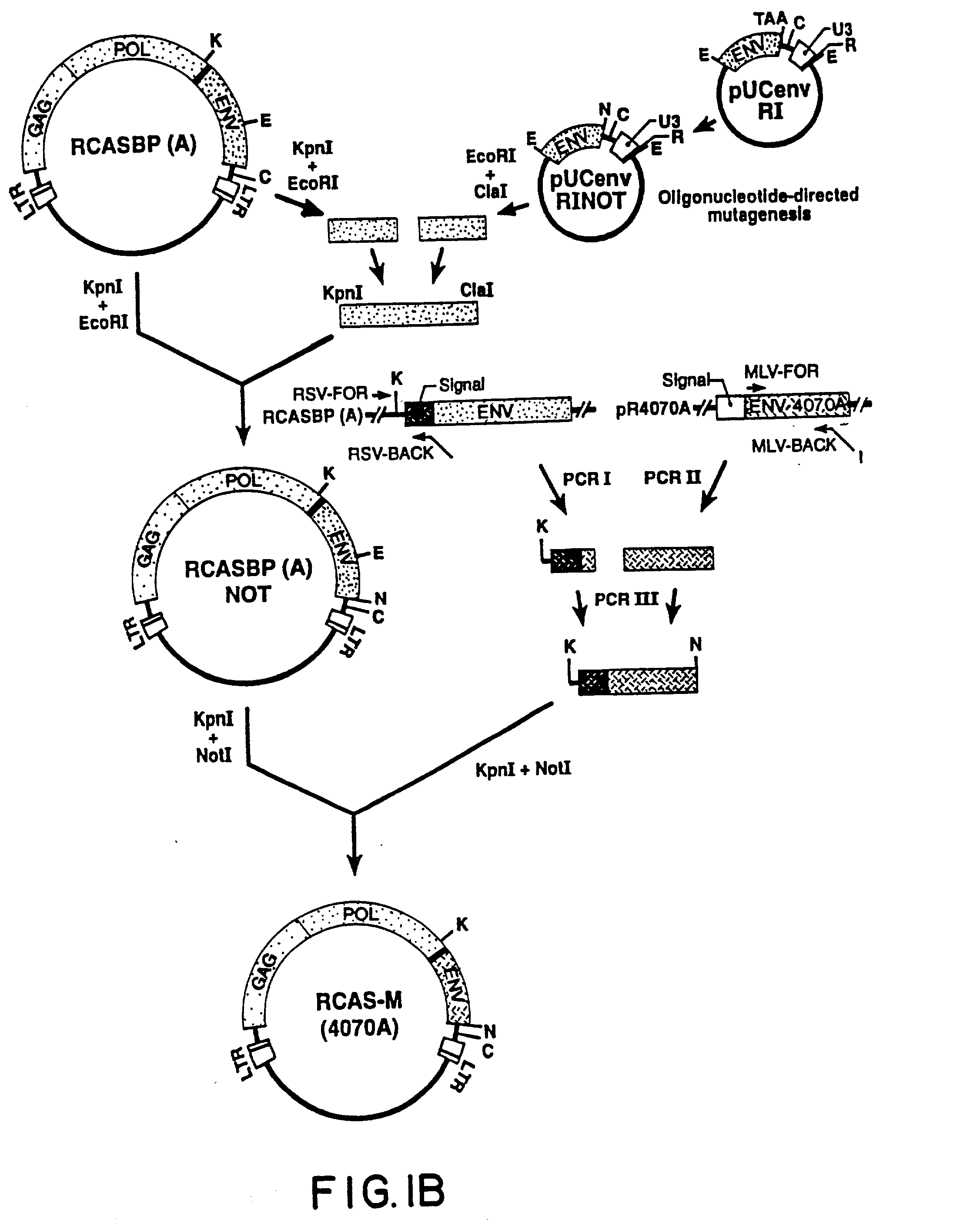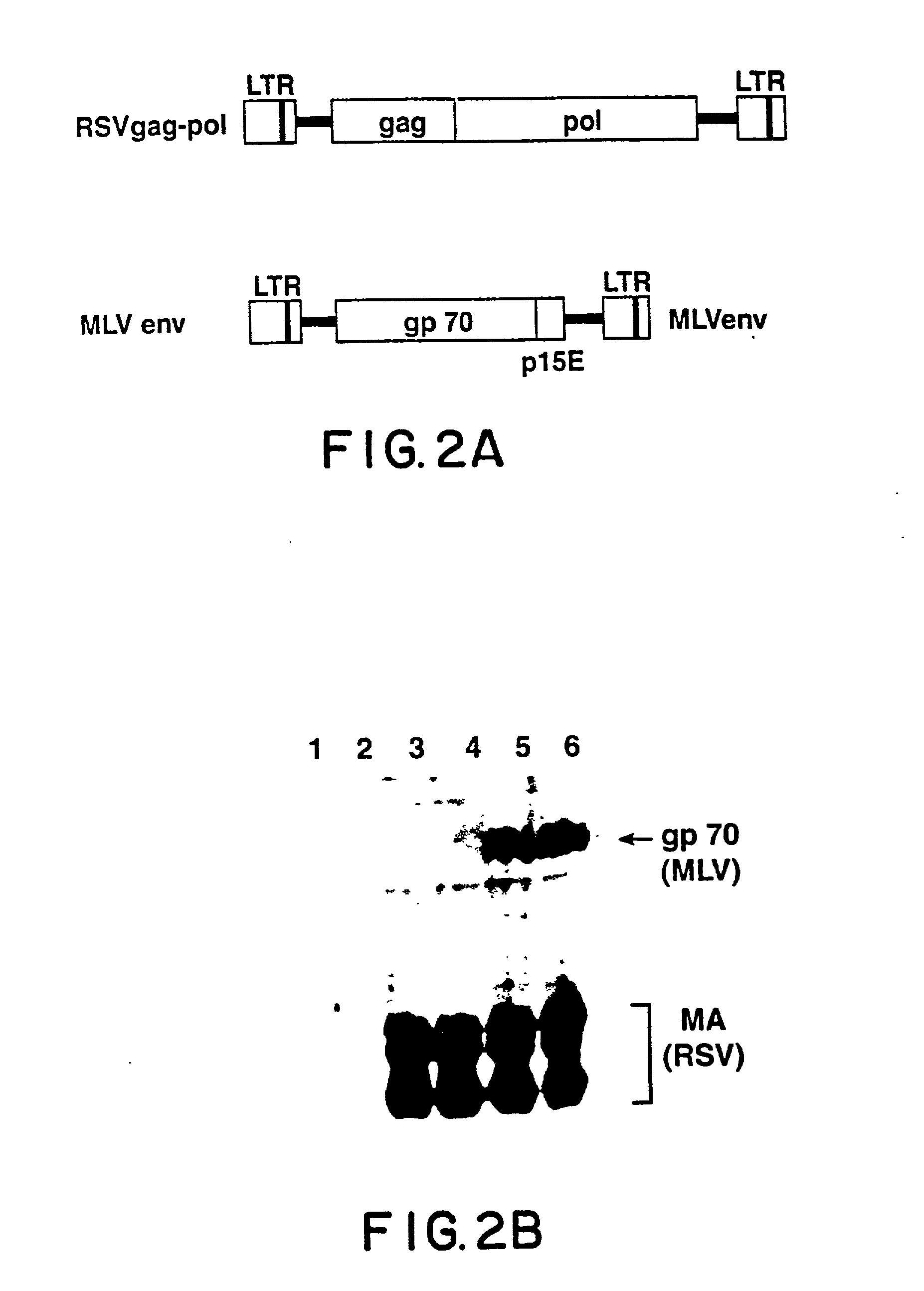Retrovirus vectors derived from avian sarcoma leukosis viruses permitting transfer of genes into mammalian cells and therapeutic uses thereof
a technology of avian sarcoma leukosis and retrovirus, which is applied in the direction of biocide, animal repellents, peptide sources, etc., can solve the problems of unable to combine all of the above features in one vector system, the vector derived from this virus is replication-defective, and it is relative easy to manipulate a cloned dna copy of the genom
- Summary
- Abstract
- Description
- Claims
- Application Information
AI Technical Summary
Benefits of technology
Problems solved by technology
Method used
Image
Examples
example 2
The Recombinant Retroviral Vector RCAS-M(4070A) Construction of RCAS-M(4070A)
[0112] Given the apparent efficiency with which the MLV envelope protein assembles with RSV gag, recombinant RSV genome was constructed in which the envelope gene in the parental virus was replaced with the env gene of an amphotropic MLV. To ensure the efficient intracellular transport of the envelope precursor and the signal peptide cleavage in avian cells, a chimeric env gene in which a sequence encoding a mature MLV gp70 was fused to the RSV envelope signal peptide. RSV env coding sequences were removed and the chimeric envelope coding region, including a new stop codon was inserted, generating the recombinant retroviral vector RCAS-M(4070A).
[0113] The recombinant retroviral vector RCAS-M(4070A) was prepared as follows. First, an Eco RI fragment of RCASBP(A) spanning the 3'-end of the RSV env gene and U3R segment of the 3'-LTR was subcloned in pUC19, giving rise to pUCenvRI (FIG. 1B). The termination cod...
example 3
Transmembrane Protein pl5E is Correctly Processed in RCAS-M(4070A) Particles
[0133] In the murine leukemia viruses, the env precursor is initially cleaved by a cellular protease into gp70 (SU) and pre-p15E (TM). After the virus particle is released from the cell, the viral protease removes the C-terminal 16 residues from the cytoplasmic domain of pre-p15E, yielding the mature p15E and p2E. Rein et al., (1994) J. Virology 68:1773-1781. This cleavage activates the membrane fusion capability of the env protein and is essential for viral infectivity.
[0134] Virions produced by cells infected with RCAS-M(4070A) do not contain MLV protease. However, the chimeric virus is infectious, suggesting that pre-p15E is cleaved. Viral particles were prepared as described in Example 1 and the proteins were fractionated on 16% SDS-PAGE and analyzed by immunoblotting with rabbit antiserum against p15E (kind gift of Alan Rein) (FIG. 7). The data shows that the chimeric virus particles formed by RCAS-M(40...
example 4
Virus Particles are not Produced by Mammalian Cells Infected with RCAS-M(4070A)
[0135] Recent studies demonstrated the development of the lymphomas in the non-human primates after gene transfer as a result of infection and spreading of the replication-competent helper MLV which was present in the retroviral vector stocks. (Donahue et al., (1992) J. Exp. Med. 176:1125-1135; Vanin et al., (1994) J. Virology 68:4241-4250). This illustrates the considerable importance of the issue of a retroviral vector safety. One of the advantages of having avian retrovirus-based vectors in a mammalian cell system is that the mammalian cells transfected or infected with RSV do not produce infectious viral particles (Federspiel et al., (1994) PNAS (U.S.A.) 91:1124-11245) and therefore the vector cannot spread in the mammalian host. Inability of RSV to synthesize or to export into the cytoplasm a full-length genomic RNA, (Berberich et al., (1990) J. Virology 64:4313-4320; Knight et al., (1993) J. Gen Vir...
PUM
| Property | Measurement | Unit |
|---|---|---|
| pH | aaaaa | aaaaa |
| nucleic acid | aaaaa | aaaaa |
| nucleic acid sequence | aaaaa | aaaaa |
Abstract
Description
Claims
Application Information
 Login to View More
Login to View More - R&D
- Intellectual Property
- Life Sciences
- Materials
- Tech Scout
- Unparalleled Data Quality
- Higher Quality Content
- 60% Fewer Hallucinations
Browse by: Latest US Patents, China's latest patents, Technical Efficacy Thesaurus, Application Domain, Technology Topic, Popular Technical Reports.
© 2025 PatSnap. All rights reserved.Legal|Privacy policy|Modern Slavery Act Transparency Statement|Sitemap|About US| Contact US: help@patsnap.com



